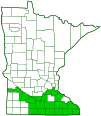tuberous Indian plantain
(Arnoglossum plantagineum)
Conservation • Wetland • Description • Habitat • Ecology • Use • Distribution • Taxonomy
Description |
||
Tuberous Indian plantain is an erect, perennial forb that rises on a rosette of basal leaves and a single stem from a horizontal underground stem (rhizome) and fleshy roots. In Minnesota it is usually 20″ to 40″ tall, though in other parts of its range it can reach 70″ in height. It occurs from Ontario to Texas and Georgia. It is most common in the Midwest from Iowa and Illinois to Texas and Louisiana. It is rare in Minnesota, where it is listed as a threatened species. The stem is erect, stout, angled, grooved, hairless, and unbranched below the inflorescence. It is green and has a fine, reddish-purple, longitudinal line on each angle, at least near the base of the plant. It is not covered with a whitish waxy bloom (glaucous). Basal leaves are thick, firm, leathery, 3″ to 8″ long, and 1″ to 3″ wide. They are on stout, greenish-white to reddish-green, up to 4″ long leaf stalks (petioles). The leaf blades are elliptic to egg-shaped, unlobed, rounded or bluntly pointed at the tip, and tapered at the base. The margins are greenish-white to reddish-green, usually untoothed, sometimes wavy, sometimes coarsely toothed. The upper and lower surfaces are hairless but not glaucous. There are 7 to 10 conspicuous, more or less parallel veins diverging from the base and converging at the tip. Stem leaves are alternate and get progressively smaller and shorter stalked as they ascend the stem. Lower stem leaves are similar in size and appearance to basal leaves. Upper stem leaves are short stalked, egg-shaped to narrowly inversely egg-shaped, and tapered at the base. They are usually untoothed, sometimes coarsely toothed. Uppermost leaves are often stalkless. The inflorescence is a flat-topped, branched, loose, 3″ to 8″ in diameter cluster (cyme) at the end of the stem. The flowers in the center on the cyme open first, the outermost flowers open last. The branches of the cyme are greenish-white and hairless. Each flower head is 5 ⁄16″ to ⅜″ long and ⅛″ to 3 ⁄16″ wide. The whorl of bracts at the base of the flower head (involucre) has sharp, wing-like keels. The bracts are green with white keels and white tips. Each flower head has five disk florets. The corollas are 5 ⁄16″ to 7 ⁄16″ long, and white or cream-colored. They have 5 lobes that strongly bend backward. They extend only slightly beyond the involucre. The style is branched and has a stigmatic band along the inner surface of each branch. The fruit is a dry, ⅛″ to 3 ⁄16″ long capsule (achene) with a tuft of ¼″ to ⅜″ long hairs attached at the end. The achene is dark brown and narrowly oval, and has 5 to 12 longitudinal ribs. |
||
Height |
||
20″ to 40″ |
||
Flower Color |
||
Greenish-white to white or cream-colored |
||
Similar Species |
||
|
||
Habitat |
||
Usually wet to moderate moisture,rarely dry. Wet prairies, pastures, and bogs. Full to partial sun. |
||
Ecology |
||
Flowering |
||
June through August |
||
Pests and Diseases |
||
|
||
Use |
||
|
||
Distribution |
||||
|
Sources |
|||
| 5/24/2023 | ||||
Nativity |
||||
Native |
||||
Occurrence |
||||
Rare in Minnesota |
||||
Taxonomy |
|||
| Kingdom | Plantae (Plants) | ||
| Division | Tracheophyta (Vascular Plants) | ||
| Subdivision | Spermatophytina (Seed Plants) | ||
| Class | Magnoliopsida (Dicots) | ||
Order |
Asterales (Sunflowers, Bellflowers, Fanflowers, and Allies) | ||
Family |
Asteraceae (Sunflowers, Daisies, Asters, and Allies) | ||
| Subfamily | Asteroideae | ||
| Supertribe | Senecionodae | ||
| Tribe | Senecioneae (groundsels and allies) | ||
| Subtribe | Tussilagininae | ||
| Genus | Arnoglossum (Indian plantains) | ||
Subordinate Taxa |
|||
|
|||
Synonyms |
|||
Cacalia plantaginea Cacalia pteranthes Cacalia tuberosa Mesadenia tuberosa |
|||
Common Names |
|||
arnoglossum groove-stem Indian-plantain groovestem Indian plantain prairie Indian plantain tuberous Indian plantain |
|||
Glossary
Achene
A dry, one-chambered, single-seeded seed capsule, formed from a single carpel, with the seed attached to the membranous outer layer (wall) only by the seed stalk; the wall, formed entirely from the wall of the superior ovary, does not split open at maturity, but relies on decay or predation to release the contents.
Axil
The upper angle where a branch, stem, leaf stalk, or vein diverges.
Bract
Modified leaf at the base of a flower stalk, flower cluster, or inflorescence.
Cyme
A branched, flat-topped or convex flower cluster in which the terminal flower opens first and the outermost flowers open last.
Glaucous
Pale green or bluish gray due to a whitish, powdery or waxy film, as on a plum or a grape.
Involucre
A whorl of bracts beneath or surrounding a flower, flower head, or flower cluster.
Petiole
On plants: The stalk of a leaf blade or a compound leaf that attaches it to the stem. On ants and wasps: The constricted first one or two segments of the rear part of the body.
Rhizome
A horizontal, usually underground stem. It serves as a reproductive structure, producing roots below and shoots above at the nodes.
Rosette
A radiating group or cluster of leaves usually on or close to the ground.
Visitor Photos |
|||||
Share your photo of this plant. |
|||||
| This button not working for you? Simply email us at info@MinnesotaSeasons.com. Attach one or more photos and, if you like, a caption. |
|||||
|
|||||
MinnesotaSeasons.com Photos |
|||||
Plant |
|||||
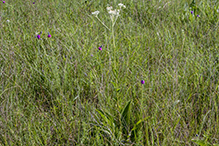 |
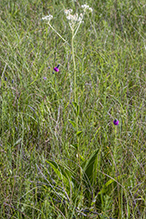 |
||||
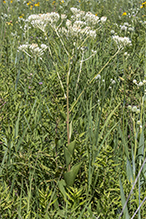 |
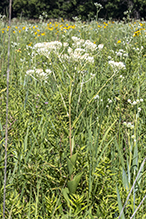 |
||||
Inflorescence |
|||||
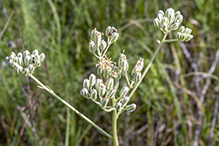 |
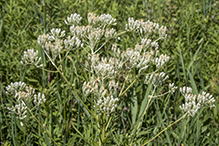 |
||||
Flowers |
|||||
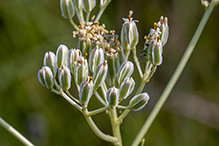 |
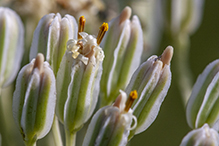 |
||||
Basal Leaves |
|||||
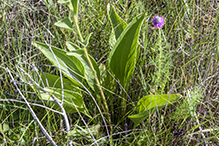 |
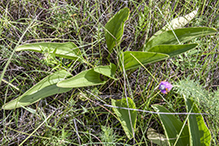 |
||||
Stem Leaves |
|||||
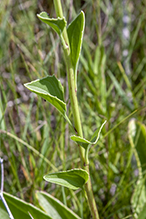 |
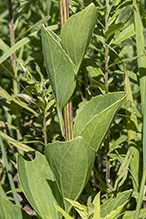 |
||||
Stem |
|||||
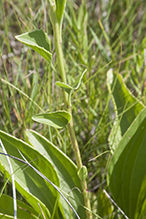 |
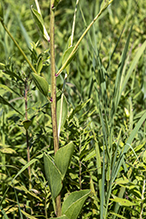 |
||||

Visitor Videos |
|||
Share your video of this plant. |
|||
| This button not working for you? Simply email us at info@MinnesotaSeasons.com. Attach a video, a YouTube link, or a cloud storage link. |
|||
Other Videos |
|||

Visitor Sightings |
|||||
Report a sighting of this plant. |
|||||
| This button not working for you? Simply email us at info@MinnesotaSeasons.com. Be sure to include a location. |
|||||
|
|||||
MinnesotaSeasons.com Sightings |
|||||

Created: 4/23/2019
Last Updated:
